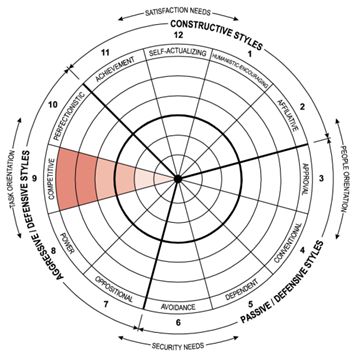In a previous article, we introduced the Human Synergistics Circumplex™, a proven framework to measure, report, discuss and better understand individual and collective human behaviour, and their impact upon business and organisational performance (refer: Catching Smoke: A Proven Framework for Addressing Culture and Leadership).
This latest article focuses on one of the Aggressive/Defensive styles – Competitive: what it’s all about, how it can hinder your personal effectiveness and/or the performance of your business/organisation and how to, at a personal and/or workplace culture level, reduce overly-competitive thinking and behaviours.

So Just What is the Competitive Style?Whether we’re looking at it from an individual leadership or broader workplace culture perspective, the Competitive style is characterised by a tendency to compete rather than cooperate, a strong “need to win”, and a tendency to constantly compare self with others.
Leaders who are personally high in the Competitive style will tend to, for example:
- try hard to impress others
- “play to win” at all costs, in all areas of life
- feel worthy only when they “win”
- are determined to be “right”, and be seen to be “right”, at all times, and
- spend a lot of time comparing themselves and their achievement to others.
Workplace cultures can themselves become overly-Competitive in nature, in which participants feel expected or implicitly required to, for example:
- compete against one another, even their work colleagues and those within their teams
- be seen and noticed, be the centre of attention
- never, ever appear to “lose”, and
- maintain an image of superiority.
So Why Should I Focus on Limiting the Competitive Style?
Let’s be clear – while a moderate level of competitive thinking and behaviour can be beneficial (it can provide energy, forward momentum, inspire persistence and short-term performance after all), it can in fact hinder individual and collective performance in the longer-term if it becomes too prominent.
Indeed, research over several decades by Human-Synergistics has consistently shown that workplaces high in the Competitive style (and the other Aggressive/Defensive styles – Oppositional, Power and Perfectionistic) are significantly less effective, particularly in the longer-term, than workplaces with predominantly Constructive cultures.
Indeed, primarily Constructive workplaces:
- are 32% more able to effectively respond to changes in the external environment
- achieve 32% higher quality performance
- demonstrate 28% more effective teamwork
- have a 25% greater commitment to producing a quality result
- include individuals that are 32% more motivated, 26% more satisfied and 25% more likely to stay with the organisation.
Individual leaders high in the Competitive style will tend to focus more on “beating others” than achieving excellence, are much less likely to cooperate with others in a way that drives and sustains high levels of performance, can tend to be personally tense/stressed and often have strained relationships with others.
Workplace cultures high in the Competitive style can be stressful and less-desirable places to work, promote behaviours that may be uncomfortable for many, will often be overly-focused on short-term measures of performance, and may find it difficult to promote a sense of unity/team.
Controlling Competitive Thinking and Behaviour
If you think you could improve your effectiveness as a leader by limiting your Competitive thinking and behaviour, try for example:
- Focus on quality, excellence and achieving a “personal best”, rather than comparing yourself to and “beating others”
- Be self-aware – accept the fact that you cannot be “best” at everything and that everyone makes mistakes/fails from time to time. Instead, recognise and appreciate your own strengths and those of others
- Make an effort to collaborate closely and constructively with another person, and reflect on the results. Was it a positive experience, how did the person respond, did it improve the outcome?
- Volunteer to mentor another person and/or explore a personal interest for the sake of enjoyment only – something that does not have a competitive element to it, where the focus is on winning.
To control Competitive thinking and behaviours at a collective/workplace level:
- Ensure recognition and reward structures promote or at least balance cooperative behaviours with competitive behaviours
- Seek out the opinions/views of, and be sure to also recognise the contributions of, the “quiet achievers” within your team
- Ensure that performance review processes and similar structures within the business are not based on comparative standards, by which employees and/or teams are rated against other employees or teams
- Be aware of the nature and tone of management communications, including team meetings: ensure that they foster genuine cooperation, teamwork and the exchange of ideas rather than competition.
We’ll continue in future articles to look at the what, why and how of other workplace culture and personal leadership styles. In the meantime, be sure to call if you’d like to explore the range of culture and leadership programs we have available to help transform your people, your team and your business/organisation.
If you’ve missed our previous articles on the other styles, be sure to check out our blog – look for the “Focus on Culture and Leadership” series of articles.

